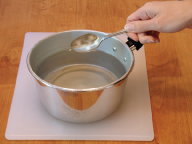Silver tarnishes because it reacts with the small amounts of smelly hydrogen sulfide, H 2 S, we
Question:
Silver tarnishes because it reacts with the small amounts of smelly hydrogen sulfide, H2S, we put into the air as we digest our food. In this reaction, the silver loses electrons to the sulfur. You can reverse this reaction by allowing the silver to get its electrons back from aluminum. Flatten some aluminum foil on the bottom of a cooking pot. Fill the pot halfway with water and bring the water to a boil. When the water boils, remove the pot from its heat source. Add a couple tablespoons of baking soda to the hot water. Slowly immerse a tarnished piece of silver in the water and allow the silver to touch the aluminum foil. You should see an immediate effect once the silver and aluminum make contact. (Add more baking soda if you don’t.) If your silver piece is very tarnished, you may notice the unpleasant odor of hydrogen sulfide as it is released back into the air.
As silver tarnishes, is it oxidized or reduced? Is baking soda, NaHCO3, an ionic compound? Why is it needed in this activity? Does aluminum behave as an oxidizing agent or a reducing agent as it restores the silver to its untarnished state?

Step by Step Answer:

Conceptual Physical Science
ISBN: 978-0134060491
6th edition
Authors: Paul G. Hewitt, John A. Suchocki, Leslie A. Hewitt





